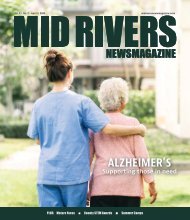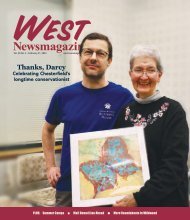Mid Rivers Newsmagazine 5-1-24
Local news, local politics and community events for St. Charles County Missouri.
Local news, local politics and community events for St. Charles County Missouri.
Create successful ePaper yourself
Turn your PDF publications into a flip-book with our unique Google optimized e-Paper software.
<strong>24</strong> I MATURE FOCUS I<br />
May 1, 20<strong>24</strong><br />
MID RIVERS NEWSMAGAZINE<br />
@MIDRIVERS_NEWS<br />
MIDRIVERSNEWSMAGAZINE.COM<br />
News & Notes<br />
By LISA RUSSELL<br />
Mature Focus<br />
Our special section featuring issues,<br />
events, products and services of<br />
interest to our 50-plus readers.<br />
COMING AGAIN June 5<br />
We’re redefining senior living<br />
with independence at the forefront.<br />
Senior living at Clarendale of St. Peters is anything but traditional.<br />
Why? We encourage and celebrate the independence of<br />
residents instead of focusing solely on their limitations. All are<br />
welcome to be themselves and make the most out of life.<br />
Discover an integrated environment between independent<br />
living and assisted living, where residents share amenities, lifeenriching<br />
experiences, and many laughs. It’s the perfect balance<br />
of freedom and support.<br />
To learn more or schedule a visit, call 636-<strong>24</strong>2-6096<br />
or visit ClarendaleOfStPeters.com.<br />
INDEPENDENT LIVING | ASSISTED LIVING | MEMORY CARE<br />
10 DuBray Drive | St. Peters, MO 63376 em ClarendaleOfStPetersLIFE@ClarendaleOfStPeters.com<br />
AI advancing ALS treatment<br />
Amyotrophic lateral sclerosis (ALS),<br />
also called Lou Gehrig’s Disease, is a<br />
frightening diagnosis. The fatal motor<br />
neuron disease, characterized by gradual<br />
degeneration of nerve cells in the spinal<br />
cord and brain, remains incurable.<br />
This May, as the U.S. marks ALS Awareness<br />
Month, development of a potential new<br />
weapon in the fight against this devastating<br />
disease is underway … one that exists<br />
thanks to artificial intelligence technology.<br />
A drug candidate currently known as<br />
FB1006 is being advanced as a potential<br />
new treatment for ALS. The Chinese<br />
company leading the drug’s development,<br />
4B Technologies, has already successfully<br />
completed patient enrollment in an initial<br />
clinical trial set to begin in August.<br />
AI technology was utilized in multiple<br />
stages of the drug’s discovery and development,<br />
including target identification,<br />
patient enrollment and efficacy assessment.<br />
The use of AI enabled the 4B Technologies<br />
team to significantly shorten the patient<br />
screening process and complete enrollment<br />
in less than one year, as well as maximize<br />
the use of the clinical data. Analysis of the<br />
trial’s results is expected in February of<br />
2025.<br />
Missed opportunities<br />
to save lives<br />
Automated external defibrillators (AEDs)<br />
can be life-savers when someone has an outof-hospital<br />
cardiac arrest … an emergency<br />
which happens more than 1,000 times every<br />
day in the U.S. on average, and is fatal in<br />
about 90% of cases. When used together<br />
with cardiopulmonary resuscitation, however,<br />
an AED – which analyzes the heart’s<br />
rhythm and delivers electric shock if necessary<br />
– greatly increases the odds of survival.<br />
While AEDs are often located nearby<br />
when cardiac arrests happen, they are very<br />
seldom used, say University of Missouri –<br />
Kansas City researchers. And this may be<br />
because people don’t know where the nearest<br />
one is located.<br />
Their recent study analyzed data from<br />
about 1,800 cardiac arrests that occurred<br />
either in homes or public places around<br />
Kansas City from 2019-2022. Despite the<br />
fact that many of these out-of-hospital cardiac<br />
arrests occurred within a four-minute<br />
walk of a public AED, the devices were<br />
used in only 13 of the cases, or less than 1%.<br />
AED devices are often available close by<br />
when someone has an out-of-hospital<br />
cardiac arrest, but they’re almost never<br />
used – an outcome that can and should<br />
be changed, say University of Missouri –<br />
Kansas City researchers. (Adobe Stock photo)<br />
“Public AED availability is critical for<br />
people to be able to use them in the appropriate<br />
time and fashion. However, people<br />
need to know it’s there to be able to use it.<br />
It’s not sufficient just to have them in the<br />
right places,” said Mirza S. Khan, M.D., a<br />
physician and medical informatician at the<br />
university and the study’s lead author.<br />
The analysis found that a large majority<br />
(about 85%) of cardiac arrests occurred at<br />
home. While someone in the home administered<br />
CPR in 42% of these cases, an AED<br />
was never used. Researchers calculated<br />
that nearly one-quarter of at-home cardiac<br />
arrests occurred within a four-minute walk<br />
of a public AED.<br />
Among the remaining 15% of cardiac<br />
arrests that occurred in public places, a<br />
bystander administered CPR in about 40%<br />
of cases as well, using an AED in only<br />
7%. Nearly half of these cardiac arrests<br />
occurred within a four-minute walk of<br />
an AED. Even in the “optimal” scenario<br />
where someone administered CPR and an<br />
AED was accessible nearby, the devices<br />
were used only about a quarter of the time.<br />
According to Khan, the study’s findings<br />
should speed efforts to improve signage<br />
around AEDs, provide apps or mapping<br />
tools to help people locate them, and<br />
increase education and awareness about<br />
these life-saving devices.<br />
Better news about eggs<br />
Eggs are a perennial breakfast favorite,<br />
but concerns that they may raise cholesterol<br />
levels and threaten heart health cause<br />
many older adults to leave eggs off their<br />
morning menus.<br />
But results from a recent trial conducted<br />
at the Duke Clinical Research Institute<br />
offer better news for egg lovers. They<br />
showed that, after a four-month period,<br />
cholesterol levels were similar among participants<br />
who ate fortified eggs most days
















